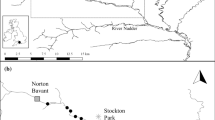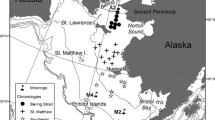Abstract
Long-term ecological datasets are vital for investigating how species respond to changes in their environment, yet there is a critical lack of such datasets from aquatic systems. We developed otolith growth ‘chronologies’ to reconstruct the growth history of a temperate estuarine fish species, black bream (Acanthopagrus butcheri). Chronologies represented two regions in south-east Australia: South Australia, characterised by a relatively warm, dry climate, and Tasmania, characterised by a relatively cool, wet climate. Using a mixed modelling approach, we related inter-annual growth variation to air temperature, rainfall, freshwater inflow (South Australia only), and El Niño–Southern Oscillation events. Otolith chronologies provided a continuous record of growth over a 13- and 21-year period for fish from South Australia and Tasmania, respectively. Even though fish from Tasmania were sourced across multiple estuaries, they showed higher levels of growth synchronicity across years, and greater year-to-year growth variation, than fish from South Australia, which were sourced from a single, large estuary. Growth in Tasmanian fish declined markedly over the time period studied and was negatively correlated to temperature. In contrast, growth in South Australian fish was positively correlated to both temperature and rainfall. The stark contrast between the two regions suggests that Tasmanian black bream populations are more responsive to regional scale environmental variation and may be more vulnerable to global warming. This study highlights the importance of examining species response to climate change at the intra-specific level and further validates the emerging use of growth chronologies for generating long-term ecological data in aquatic systems.




Similar content being viewed by others
References
Audzijonyte A, Kuparinen A, Gorton R, Fulton EA (2013) Ecological consequences of body size decline in harvested fish species: positive feedback loops in trophic interactions amplify human impact. Biol Lett 9:20121103
Barton K (2013) MuMIn: multi-model inference. R package version 1.9.13. http://CRAN.R-project.org/package=MuMIn
Bates D, Maechler M, Bolker B, Walker S (2015) lme4: Linear mixed-effects models using Eigen and S4. R package version 1.1-8. http://CRAN.R-project.org/package=lme4
Black BA, Allman RJ, Schroeder ID, Schirripa MJ (2011) Multidecadal otolith growth histories for red and gray snapper (Lutjanus spp.) in the northern Gulf of Mexico, USA. Fish Oceanogr 20:347–356
Black BA, Matta ME, Helser TE, Wilderbuer TK (2013) Otolith biochronologies as multidecadal indicators of body size anomalies in yellowfin sole (Limanda aspera). Fish Oceanogr 6(22):523–532
Bucater LB, Livore JP, Noell CJ, Ye Q (2013) Temporal variation of larval fish assemblages of the Murray Mouth in prolonged drought conditions. Mar Freshw Res 64:932–937
Burnham KP, Anderson DR (2004) Multimodel inference: understanding AIC and BIC in model selection. Sociol Methods Res 33:261–304
Burridge CP, Versace VL (2007) Population genetic structuring in Acanthopagrus butcheri (Pisces: sparidae): does low gene flow among estuaries apply to both sexes? Mar Biotechnol 9:33–44
Burridge CP, Hurt AC, Farrington LW, Coutin PC, Austin CM (2004) Stepping stone gene flow in an estuarine-dwelling sparid from South–East Australia. J Fish Biol 64:805–819
Coulson P, Black B, Potter I, Hall N (2014) Sclerochronological studies reveal that patterns of otolith growth of adults of two co-occurring species of Platycephalidae are synchronised by water temperature variations. Mar Biol 161:383–393
Edgar GJ, Barrett NS, Graddon DJ (1999) A classification of Tasmanian estuaries and assessment of their conservation significance using ecological and physical attributes, population and land use. Tasmanian Aquaculture and Fisheries Institute, University of Tasmania, Hobart
Elsdon TS, Gillanders BM (2006) Identifying migratory contingents of fish by combining otolith Sr:Ca with temporal collections of ambient Sr:Ca concentrations. J Fish Biol 69:643–657
Fangue NA, Hofmeister M, Schulte PM (2006) Intraspecific variation in thermal tolerance and heat shock protein gene expression in common killifish, Fundulus heteroclitus. J Exp Biol 209:2859–2872
Ferguson G, Ye Q (2008) Black bream (Acanthopagrus butcheri) stock assessment report for PIRSA. In: South Australian Research and Development Institute (Aquatic Sciences), F2008/000810-1 SARDI Adelaide, Research Report Series No. 310
Ferguson G, Ward T, Ye Q, Geddes M, Gillanders B (2013) Impacts of drought, flow regime, and fishing on the fish assemblage in southern Australia’s largest temperate estuary. Estuar Coasts 36:737–753
Fox J (2003) Effect displays in R for generalised linear models. J Stat Softw 8:1–27
Garcia SM, Rosenberg AA (2010) Food security and marine capture fisheries: characteristics, trends, drivers and future perspectives. Philos Trans R Soc Lond B 365:2869–2880
Gillanders BM, Kingsford MJ (2002) Impact of changes in flow of freshwater on estuarine and open coastal habitats and the associated organisms. In: Gibson R, Barnes M, Atkinson R (eds) Oceanography and marine biology: an annual review, vol 40, p 233
Gillanders BM, Elsdon TS, Halliday IA, Jenkins GP, Robins JB, Valesini FJ (2011) Potential effects of climate change on Australian estuaries and fish utilising estuaries: a review. Mar Freshw Res 62:1115–1131
Gillanders BM, Black BA, Meekan MG, Morrison MA (2012) Climatic effects on the growth of a termperate reef fish from the Southern Hemisphere: a biochronological approach. Mar Biol 159:1327–1333
Gillanders BM, Izzo C, Doubleday ZA, Ye Q (2015) Partial migration: growth varies between resident and migratory fish. Biol Lett 11:20140850
Haddy JA, Pankhurst NW (1998) Annual change in reproductive condition and plasma concentrations of sex steroids in black bream, Acanthopagrus butcheri (Munro) (Sparidae). Mar Freshw Res 49:389–397
Hamilton V, Evans K, Raymond B, Hindell MA (2013) Environmental influences on tooth growth in sperm whales from southern Australia. J Exp Mar Biol Ecol 446:236–244
Hobday A, Pecl G (2014) Identification of global marine hotspots: sentinels for change and vanguards for adaptation action. Rev Fish Biol Fish 24:415–425
Holbrook NJ et al. (2009) El Niño-Southern oscillation. In: Poloczanska ES, Hobday AJ, Richardson AJ (eds) A marine climate change impacts and adaptation report card for Australia 2009. NCCARF, Publication 05/09
Holmlund CM, Hammer M (1999) Ecosystem services generated by fish populations. Ecol Econ 29:253–268
Jenkins G, Conron S, Morison A (2010) Highly variable recruitment in an estuarine fish is determined by salinity stratification and freshwater flow: implications of a changing climate. Mar Ecol Prog Ser 417:249–261
Kendall NW, Rich HB, Jensen LR, Quinn TP (2010) Climate effects on inter-annual variation in growth of the freshwater mussel (Anodonta beringiana) in an Alaskan lake. Freshw Biol 55:2339–2346
Lough JM, Hobday AJ (2011) Observed climate change in Australian marine and freshwater environments. Mar Freshw Res 62:984–999
Lyle JM, Tracey SR, Stark KE, Wotherspoon S (2009) 2007–08 survey of recreational fishing in Tasmania. Tasmanian Aquaculture and Fisheries Institute, University of Tasmania, Hobart, Technical Report
Morison AK, Coutin PC, Robertson SG (1998) Age determination of black bream, Acanthopagrus butcheri (Sparidae), from the Gippsland Lakes of South-Eastern Australia indicates slow growth and episodic recruitment. Mar Freshw Res 49:491–498
Morrongiello JR, Thresher RE (2015) A statistical framework to explore ontogenetic growth variation among individuals and populations: a marine fish example. Ecol Monogr 85:93–115
Morrongiello JR, Crook DA, King AJ, Ramsey DSL, Brown P (2011) Impacts of drought and predicted effects of climate change on fish growth in temperate Australian lakes. Glob Change Biol 17:745–755
Morrongiello JR, Thresher RE, Smith DC (2012) Aquatic biochronologies and climate change. Nat Clim Change 2:849–857
Morrongiello JR, Walsh CT, Gray CA, Stocks JR, Crook DA (2014) Environmental change drives long-term recruitment and growth variation in an estuarine fish. Glob Change Biol 20:1844–1860
Neuheimer AB, Thresher RE, Lyle JM, Semmens JM (2011) Tolerance limit for fish growth exceeded by warming waters. Nat Clim Change 1:110–113
Newton JR, Smith-Keune C, Jerry DR (2010) Thermal tolerance varies in tropical and sub-tropical populations of barramundi (Lates calcarifer) consistent with local adaptation. Aquaculture 308 (Suppl 1):S128–S132
Ochwada-Doyle F, Roberts D, Gray C, Barnes L, Haddy J, Fearman J (2012) Characterizing the biological traits and life history of Acanthopagrus (Sparidae) hybrid complexes: implications for conservation and management. J Fish Biol 81:1540–1558
Partridge GJ, Jenkins GI (2002) The effect of salinity on growth and survival of juvenile black bream (Acanthopagrus butcheri). Aquaculture 210:219–230
Pecl G et al (2014) Rapid assessment of fisheries species sensitivity to climate change. Clim Change 127:505–520
Poloczanska ES et al (2007) Climate change and Australian marine life. Oceanogr Mar Biol Annu Rev 45:407–478
Pörtner HO, Farrell AP (2008) Physiology and climate change. Science 322:690–692
Pörtner HO, Peck MA (2010) Climate change effects on fishes and fisheries: towards a cause-and-effect understanding. J Fish Biol 77:1745–1779
Potter IC, Hyndes GA (1999) Characteristics of the ichthyofaunas of southwestern Australian estuaries, including comparisons with holarctic estuaries and estuaries elsewhere in temperate Australia: a review. Aust J Ecol 24:395–421
R Development Core Team (2008) R: a language and environment for statistical computing. R Foundation for Statistical Computing, Vienna
Richardson AJ, Poloczanska ES (2008) Under-resourced, under threat. Science 320:1294–1295
Rountrey AN, Coulson PG, Meeuwig JJ, Meekan M (2014) Water temperature and fish growth: otoliths predict growth patterns of a marine fish in a changing climate. Glob Change Biol 20:2450–2458
Sakabe R, Lyle JM, Crawford CM (2011) The influence of freshwater inflows on spawning success and early growth of an estuarine resident fish species, Acanthopagrus butcheri. J Fish Biol 78:1529–1544
Sarre GA, Potter IC (1999) Comparisons between the reproductive biology of black bream Acanthopagrus butcheri (Teleostei: sparidae) in four estuaries with widely differing characteristics. Int J Salt Lake Res 8:179–210
Scavia D et al (2002) Climate change impacts on US. Coastal and marine ecosystems. Estuaries 25:149–164
Sorte CJB, Jones SJ, Miller LP (2011) Geographic variation in temperature tolerance as an indicator of potential population responses to climate change. J Exp Mar Biol Ecol 400:209–217
Statham PJ (2012) Nutrients in estuaries—an overview and the potential impacts of climate change. Sci Total Environ 434:213–227
Thresher RE, Koslow JA, Morison AK, Smith DC (2007) Depth-mediated reversal of the effects of climate change on long-term growth rates of exploited marine fish. Proc Natl Acad Sci USA 104:7461–7465
van Dijk AIJM et al (2013) The Millennium Drought in southeast Australia (2001–2009): natural and human causes and implications for water resources, ecosystems, economy, and society. Water Resour Res 49:1040–1057
Weisberg S, Spangler G, Richmond LS (2010) Mixed effects models for fish growth. Can J Fish Aquat Sci 67:269–277
Zuur AF, Ieno EN, Walker NJ, Saveliev AA, Smith GM (2009) Mixed effects models and extensions in ecology with R. Springer, New York
Acknowledgments
We would like to thank Ryuji Sakabe, David Fleer and David Short for providing otolith samples and associated data, Vidya Kare for assisting with otolith preparation, and John Morrongiello and Gretchen Grammer for their advice on otolith chronology development and mixed modelling. This research was funded by an ARC Discovery grant (DP110100716) and Future Fellowship (FT100100767) awarded to BMG.
Author contribution statement
ZAD, CI and BMG conceived and designed the research; JAH, QY, and JML provided prepared field samples; ZAD collected and analysed the data and wrote the manuscript; all authors discussed results and commented on manuscript drafts.
Author information
Authors and Affiliations
Corresponding author
Ethics declarations
Conflict of interest
The authors declare that they have no conflict of interest.
Statement of animal rights
All applicable institutional guidelines for the care and use of animals were followed.
Additional information
Communicated by Steve Swearer.
Electronic supplementary material
Below is the link to the electronic supplementary material.
Rights and permissions
About this article
Cite this article
Doubleday, Z.A., Izzo, C., Haddy, J.A. et al. Long-term patterns in estuarine fish growth across two climatically divergent regions. Oecologia 179, 1079–1090 (2015). https://doi.org/10.1007/s00442-015-3411-6
Received:
Accepted:
Published:
Issue Date:
DOI: https://doi.org/10.1007/s00442-015-3411-6




